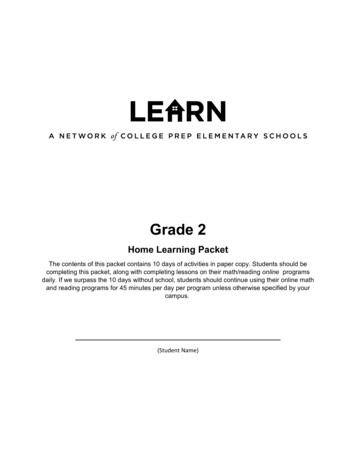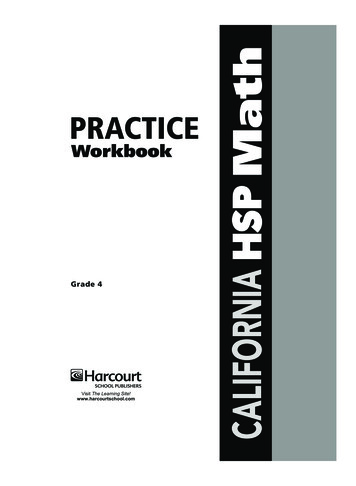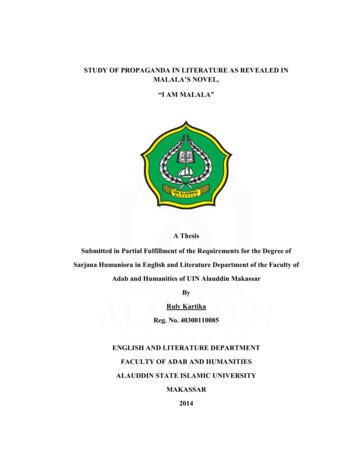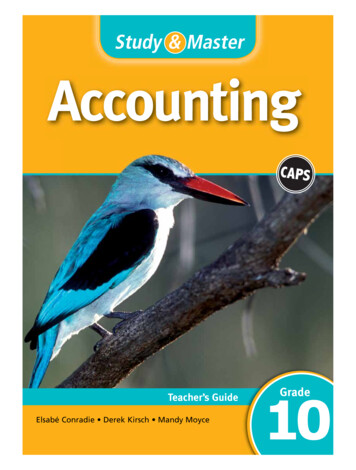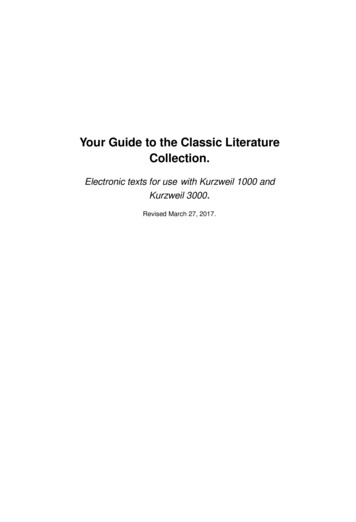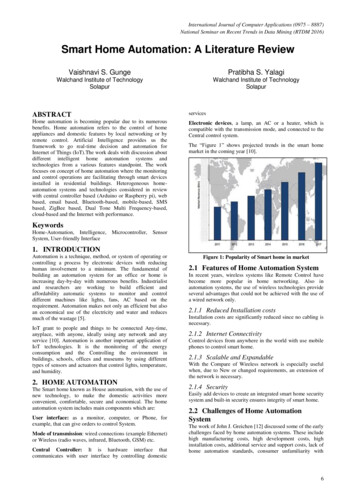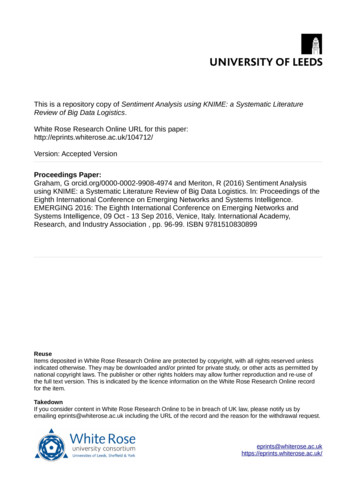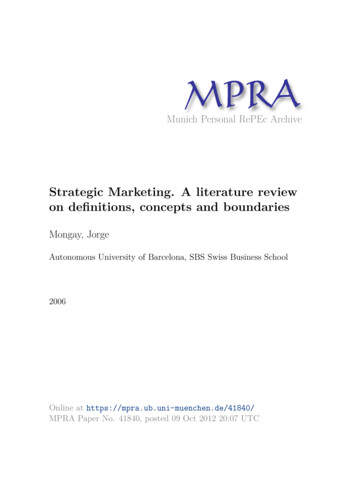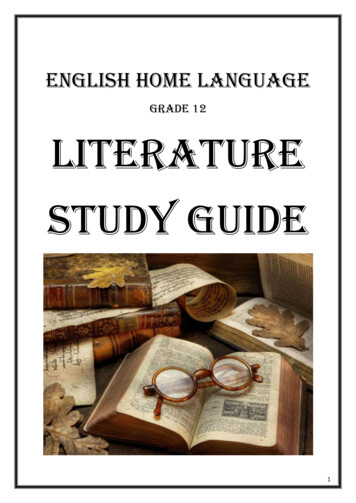
Transcription
English home languageGrade 12literatureStudy guide1
ForewordThank you to all the English Home Language teachers from across the country for your input.The main idea behind this guide is to provide a question bank for learners, as there are noprevious papers on the new literature texts. For that reason as well, I have elected to only usethe new texts as there is a lot available in the form of previous papers on the internet.I would like to make this a growing guide to which we continually add questions and ideas.The guide has been structured into sections that cover the poetry, novels and the dramas, withthe answers at the back of the guide.The unseen poetry has also been added.Thank you to Liezel Vrey, Karin Petersen and Karen Steyn for assisting with the proof readingand editing.We tried as far as possible to structure everything into the same format, but because everyonedoes not use the same program, there are some problems with the layout. Personally I type alldocs on Microsoft Word 2007. Copying from Pdf files also posed a problem, but we tried.SOME TIPS FOR SETTING A GRADE 12 PAPER Follow the exam guidelines as set out by the department of education:- A paper 2 MUST consist of FOUR prescribed poems- ONE UNSEEN poem – CONTEXTUAL QUESTION ONLY- An essay question for Novel and Drama- A Contextual Section for Novel and drama- Look at the layout for previous paper 2s as the format HAS changed inthe past few years.- Papers are typed in ARIAL 12 Font- Although there is no set rule, one mark questions seldom occur (if ever –check previous papers) in paper 2.The exam guidelines and rubrics form part of this study guide.Linda Holm2
INDEXPOETRY (p 5 – 27)EssayTITLEThe Garden of LoveThe Zulu GirlVulturesThe First Day After the WarMotho Ke Motho Ka Batho Babangsomewhere i have never travelled, gladlybeyondRememberAn African ThunderstormQUESTIONS1.11.2, 1.3, 1.41.5, ESTIONS2.1 (2.1.1 – 2.1.6)2.2 (2.2.1 – 2.2.4)2.3 (2.3.1 – 2.3.6)2.4 (2.4.1 – 2.4.3)2.5 (2.5.1 – 2.5.2)2.6 (2.6.1 – 2.6.4)2.7 (2.7.1 – 2.7.2)2.8 (2.8.1 – 2.8.4)2.9 (2.9.1 – 2.9.5)2.10 (2.10.1 – 2.10.2)2.11 EMO1041041051051051061061071071071081081.10, 1.111.12Contextual questionsTITLEFirst Day After the WarRememberFuneral BluesFelix RandalAn African ThunderstormVulturesThe Garden of LoveA Hard FrostThe Zulu GirlMotho Ke Motho Ka Bathu BabangAn African ElegyUnseen poetryTITLEDeath is nothing at allAn African HeartbeatToday I do not love my countryVisiting RoomHow not to stopThe ShipwreckChildhood in HeidelbergMagnolia ClinicThe Right WordMy African HomePortrait of a MachinePerceptions3.13.2 (no questions)3.33.43.53.63.73.83.93.103.113.123
NOVELLife of PiTITLEEssay questionContextual 849MEMO121127QUESTIONSPAGE6060MEMO1331354.1 – 4.55.1 – 5.5Picture of Dorian GrayTITLEEssay questionContextual questions6.1 – 6.77.1 – 7.7DRAMAHamletTITLEEssay questionContextual questions8.1 – 8.79.1 – 9.7NO questions on ‘Othello’ or ‘The Crucible’ were included as there are ample resources available.4
PoetryQUESTION 1:POETRY ESSAYNOTE THAT THE POETRY ESSAY IS 250 – 300 WORDS AND IS MARKED WITH THEPOETRY RUBRIC INCLUDED IN THIS STUDY GUIDE.THE GARDEN OF LOVE–William BlakeI went to the Garden of Love,And saw what I never had seen:A Chapel was built in the midst,Where I used to play on the green.And the gates of this Chapel were shut,And Thou shalt not. writ over the door;So I turn'd to the Garden of Love,That so many sweet flowers bore,And I saw it was filled with graves,And tomb-stones where flowers should be:And Priests in black gowns were walking their rounds,And binding with briars my joys & desires.510Question 1.1:The poet seems to reflect in this poem, not only how things have changed since his childhood,but also how something, like religion can change how life is lived.With reference to the use of imagery, diction and structure, discuss the theme of nostalgia andthe despair in change.Your response should take the form of a well-constructed essay of 250–300 words.[10]5
THE ZULU GIRL-R CampbellWhen in the sun the red hot acres smoulder,Down where the sweating gang its labours plies,A girl flings down her hoe, and from her shoulderUnslings her child tormented by the flies.4She takes him to a ring of shadow pooledBy thorn-trees: purples with the blood of ticks,While her sharp nails, in slow caresses ruled,Prowl through his hair with sharp electric clicks.His sleepy mouth plugged by the heavy nipple,Tugs like a puppy, grunting as he feeds:Through his frail nerves her own deep languors rippleLike a broad river sighing through its reeds.812Yet in that drowsy stream his flesh imbibesAn old unquenched unsmotherable heatThe curbed ferocity of beaten tribes,The sullen dignity of their defeat.Her body looms above him like a hillWithin whose shade a village lies at rest.Or the first cloud so terrible and stillThat bears the coming harvest in its breast.1620Question 1.2The young child is a symbol for the tenacity and strength of the entire Zulu nation. His mother inturn imparts on him, not only breast milk, but also strength to endure hardships.Write an essay of 250 – 300 words in which you explore how the diction and the imagery ofthe poem reinforce this statement.[10]Question 1.3:At first glance the central idea of the poem appears very simplistic – a young mother feeding herchild. However, the poet’s underlying message is that an ethnic group is being oppressed andthe girl shows the reaction to this injustice and hardship.Critically comment in an essay of 250 – 300 words (about ONE page), on how the poet revealsthe poem’s theme through the use of atmosphere, setting and the use of especially figurativelanguage in the poem.[10]Question 1.4:Critically discuss how the poet uses mood, setting and figurative language to reveal thetheme of the poem.Your response should take the form of a well-constructed essay of 250-300 words (about ONEpage).[10]6
VULTURES-Chinua AchebeIn the greynessand drizzle of one despondentdawn unstirred by harbingersof sunbreak a vultureperching high on brokenbone of a dead treenestled close to hismate his smoothbashed-in head, a pebbleon a stem rooted ina dump of grossfeathers, inclined affectionatelyto hers. Yesterday they pickedthe eyes of a swollencorpse in a water-loggedtrench and ate thethings in its bowel. Fullgorged they chose their roostkeeping the hollowed remnantin easy range of coldtelescopic eyes Strangeindeed how love in otherways so particularwill pick a cornerin that charnel-housetidy it and coil up there, perhapseven fall asleep – her faceturned to the wall! Thus the Commandant at BelsenCamp going home forthe day with fumes ofhuman roast clingingrebelliously to his hairynostrils will stopat the wayside sweet-shopand pick up some chocolatefor his tender offspringwaiting at home for Daddy’sreturn Praise bounteousprovidence if you willthat grants even an ogrea tiny glow-wormtenderness encapsulatedin icy caverns of a cruelheart or else despairfor in the very germof that kindred love islodged the perpetuityof evil.5101520253035404550Question 1.5:In an essay of 250 – 300 words show how the poet uses structure, diction and imagery toportray the themes.[10]7
Question 1.6:Critically discuss Achebe’s ideas about good and evil, as expressed in this poem. Pay closeattention to diction and imagery.[10]The First Day After The War-Mazisi KuneneWe heard the songs of a wedding party.We saw a soft lightCoiling round the young blades of grassAt first we hesitated, then we saw her footprints,Her face emerged, then her eyes of freedom!She woke us up with a smile saying,‘What day is this that comes suddenly?’We said, ‘It is the first day after the war’.Then without waiting we ran to the open spaceUlulating to the mountains and the pathwaysCalling people from all the circles of the earth.We shook up the old man demanding a festivalWe asked for all the first fruits of the season.We held hands with a strangerWe shouted across the waterfallsPeople came from all landsIt was the first day of peace.We saw our Ancestors travelling tall on the horizon.51015Question 1.7:In a well-constructed essay of 250-300 words, discuss how Kunene expresses with the use ofimagery and diction the way that the people of South Africa responded to and celebrated theend of Apartheid.[10]8
Motho Ke Motho Ka Batho Babang-Jeremy Cronin(A Person is a Person Because of Other People)By holding my mirror out of the window I seeClear to the end of the passage.There’s a person down there.A prisoner polishing a doorhandle.In the mirror I see him seeMy face in the mirror,I see the fingertips of his free handBunch together, as if to makeAn object the size of a badgeWhich travels up to his foreheadThe place of an imaginary cap.(This means: A warder)Two fingers are extended in a veeAnd wiggle like two antennae.(He’s being watched.)A finger of his free hand makes a watch-hand’s arcOn the wrist of his polishing arm withoutDisrupting the slow-slow rhythm of his work.(Later. Maybe later we can speak.)Hey! Wat maak jy daar?a voice from around the corner.No. Just polishing baas.He turns back to me, now watchHis free hand, the talkative on,Slips quietly behindStrength brother, it says,In my mirror,A black fist510152025Question 1.8:With reference to line 26, ‘Strength brother’, discuss the poet’s demonstration of the concept of“Ubuntu” in an essay of 250 – 300 words.Your answer should include reference to poetic techniques used by the poet.[10]9
somewhere i have never travelled, gladly beyond - ee cummingssomewhere i have never travelled, gladly beyondany experience, your eyes have their silence:in your most frail gesture are things which enclose me,or which i cannot touch because they are too nearyour slightest look easily will unclose methough i have closed myself as fingers,you open always petal by petal myself as spring opens(touching skilfully, mysteriously)her first rose5or if your wish be to close me, i andmy life will shut very beautifully, suddenly,as when the heart of this flower imaginesthe snow carefully everywhere descending;10nothing which we are to perceive in this world equalsthe power of your intense fragility: whose texturecompels me what the colour of its countries,rendering death and forever with each breathing15(i do not know what it is about you that closesand opens; only something in me understandsthe voice of your eyes is deeper than all roses)nobody, not even the rain, has such small hands20Question 1.9:This poem shows man and nature connected in some kind of harmony.By close reference to diction, imagery and tone critically discuss this statement.Your response should take the form of a well-constructed essay of 250–300 words.REMEMBER-[10]CHRISTINA ROSETTIRemember me when I am goneGone far away into the silent land;When you can no more hold me by the hand,Nor I half turn to go yet turning stay.Remember me when no more day by dayYou tell me of our future that you planned:Only remember me; understandIt will be late to counsel then or pray.Yet if you should forget me for a whileAnd afterwards remember, do not grieve:For if the darkness and corruption leaveA vestige of the thought that once I had,Better by far you should forget and smileThan you should remember and be sad.510Question 1.10:With close reference to the form and structure, as well as the tone, imagery, diction andpoetic devices used in this poem, discuss how the speaker explores the contrasting reactionsof man pertaining to death.Your response should take the form of a well-constructed essay of 250–300 words (about ONEpage).[10]10
Question 1.11:In a well-worded essay of 200 – 250 words, critically discuss how the poet highlights herevolving attitude towards her impending death.[10]AN AFRICAN THUNDERSTORM - David RubadiriFrom the westClouds come hurrying with the windTurningsharplyHere and thereLike a plague of locustsWhirlingTossing up things on its tailLike a madman chasing nothing.Pregnant cloudsRide stately on its back,Gathering to perch on hillsLike sinister dark wings;The wind whistles byAnd trees bend to let it pass.In the villageScreams of delighted children,Toss and turnIn the din of the whirling wind,Women Babies clinging on their backs Dart aboutIn and outMadlyThe wind whistles byWhilst trees bend to let it pass.Clothes wave like tattered flagsFlying offTo expose dangling breastsAs jagged blinding flashesRumble, tremble and crackAmidst the smell of fired smokeAnd the pelting march of the storm.51015202530Question 1.12:With close reference to the structure, theme, imagery and tone, discuss how the poetsucceeds in describing an African thunderstorm.[10]11
QUESTION 2:POETRY CONTEXTUAL QUESTIONSQuestion 2.1:FIRST DAY AFTER THE WAR – MAZISI KUNENEWe heard the songs of a wedding party.We saw a soft lightCoiling round the young blades of grassAt first we hesitated, then we saw her footprints,Her face emerged, then her eyes of freedom!She woke us up with a smile saying,‘What day is this that comes suddenly?’We said, ‘It is the first day after the war’.Then without waiting we ran to the open spaceUlulating to the mountains and the pathwaysCalling people from all the circles of the earth.We shook up the old man demanding a festivalWe asked for all the first fruits of the season.We held hands with a strangerWe shouted across the waterfallsPeople came from all landsIt was the first day of peace.We saw our Ancestors travelling tall on the horizon.51015Question 2.1.11. Line ONE refers to a wedding. Given the title of the poem, why is this surprising?(2)2. Refer to line 12. Who is the ‘old man’?(2)3. Comment on the poet’s use of literal and figurative language in the poem.(2)4. Refer to line 18.Comment on the effectiveness of the alliteration in ‘travelling tall’.(2)5. Critically discuss the poem’s effectiveness
Study guide . 2 Foreword Thank you to all the English Home Language teachers from across the country for your input. The main idea behind this guide is to provide a question bank for learners, as there are no previous papers on the new literature texts. For that reason as well, I have elected to only use the new texts as there is a lot available in the form of previous papers on the internet .
